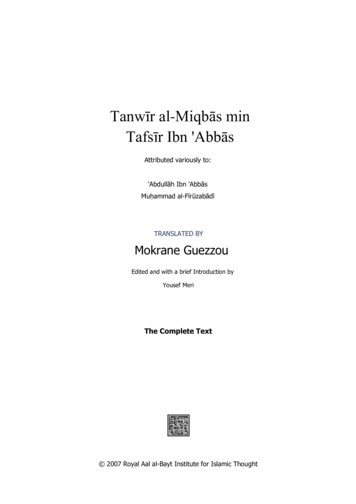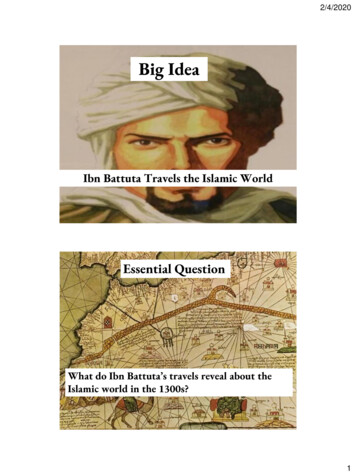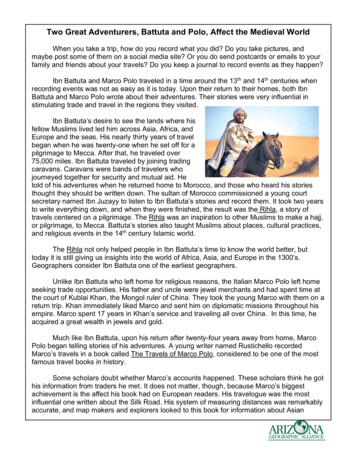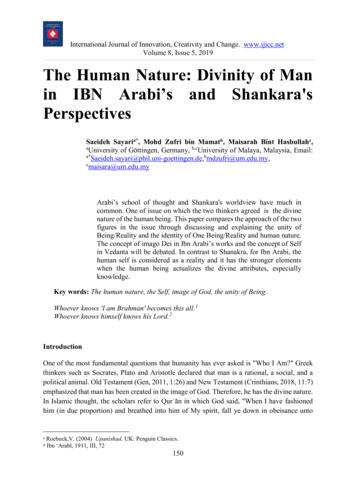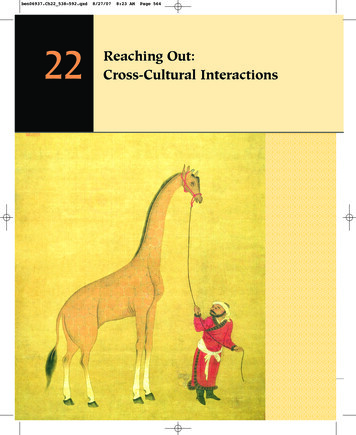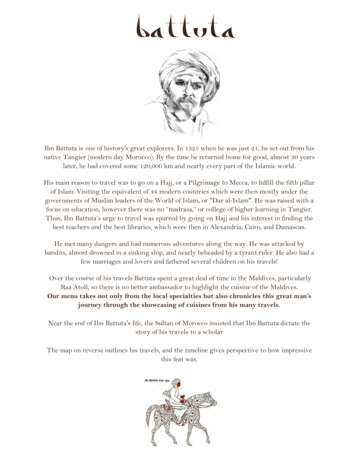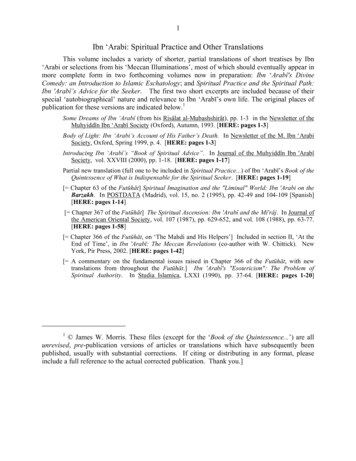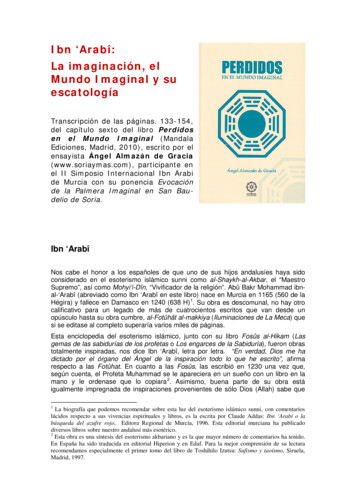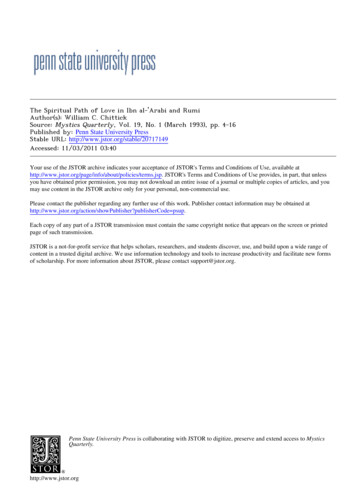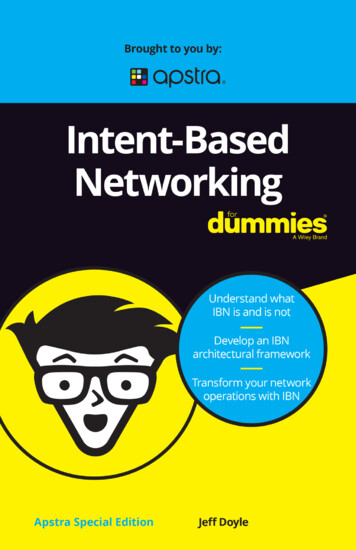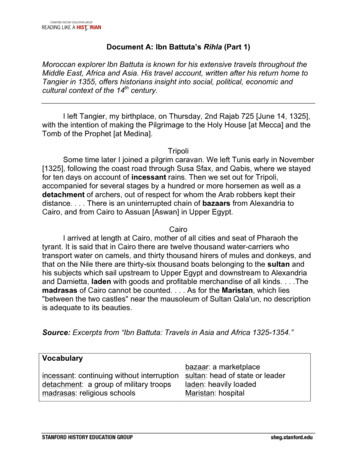
Transcription
Document A: Ibn Battuta’s Rihla (Part 1)Moroccan explorer Ibn Battuta is known for his extensive travels throughout theMiddle East, Africa and Asia. His travel account, written after his return home toTangier in 1355, offers historians insight into social, political, economic andcultural context of the 14th century.I left Tangier, my birthplace, on Thursday, 2nd Rajab 725 [June 14, 1325],with the intention of making the Pilgrimage to the Holy House [at Mecca] and theTomb of the Prophet [at Medina].TripoliSome time later I joined a pilgrim caravan. We left Tunis early in November[1325], following the coast road through Susa Sfax, and Qabis, where we stayedfor ten days on account of incessant rains. Then we set out for Tripoli,accompanied for several stages by a hundred or more horsemen as well as adetachment of archers, out of respect for whom the Arab robbers kept theirdistance. . . . There is an uninterrupted chain of bazaars from Alexandria toCairo, and from Cairo to Assuan [Aswan] in Upper Egypt.CairoI arrived at length at Cairo, mother of all cities and seat of Pharaoh thetyrant. It is said that in Cairo there are twelve thousand water-carriers whotransport water on camels, and thirty thousand hirers of mules and donkeys, andthat on the Nile there are thirty-six thousand boats belonging to the sultan andhis subjects which sail upstream to Upper Egypt and downstream to Alexandriaand Damietta, laden with goods and profitable merchandise of all kinds. . . .Themadrasas of Cairo cannot be counted. . . . As for the Maristan, which lies"between the two castles" near the mausoleum of Sultan Qala'un, no descriptionis adequate to its beauties.Source: Excerpts from “Ibn Battuta: Travels in Asia and Africa 1325-1354.”Vocabularybazaar: a marketplaceincessant: continuing without interruption sultan: head of state or leaderdetachment: a group of military troopsladen: heavily loadedmadrasas: religious schoolsMaristan: hospitalSTANFORD HISTORY EDUCATION GROUPsheg.stanford.edu
Document B: Ibn Battuta’s Rihla (Part 2)Crossing the border into Syria (1326)At the station of Qatya customs-dues are collected from themerchants, and their goods and baggage are thoroughly examined andsearched. There are offices here, with officers, clerks, and notaries, and thedaily revenue is a thousand gold dinars. No one is allowed to pass intoSyria without a passport from Egypt, nor into Egypt without a passport fromSyria, for the protection of the property of the subjects and as a measure ofprecaution against spies from Iraq.DamascusI entered Damascus on Thursday 9th Ramadan 726 [9th August,1326], and lodged at the Malikite college. Damascus surpasses all othercities in beauty, and no description can do justice to its charms. TheCathedral Mosque, known as the Umayyad Mosque, is the mostmagnificent mosque in the world. When the new moon of the monthShawwal appeared in the same year [1st September, 1326], the caravan leftDamascus and I set off along with it. . . . On the third day after leavingDamascus the great caravan halted at Tabuk for four days to rest and towater the camels and pack water for the terrible desert between Tabukand al-Ula.MeccaI got rid of my tailored clothes, bathed, and putting on the pilgrim’sgarment, I prayed and dedicated myself to the pilgrimage. The inhabitantsof Mecca have many excellent and noble activities and qualities. They aregood to the humble and weak, and kind to strangers. When any of themmakes a feast, he begins by giving food to the religious devotees who arepoor and without resources.Source: Excerpts from “Ibn Battuta: Travels in Asia and Africa 1325-1354.”VocabularyMalikite: one of four schools of Islamic lawSTANFORD HISTORY EDUCATION GROUPsheg.stanford.edu
Document C: Ross DunnPublished in 1986, Ross Dunn’s The Adventures of Ibn Battuta attempts toreconstruct Ibn Battuta’s journey. In a footnote, Dunn, a professor of historyat San Diego State University, notes that Ibn Battuta’s account of hisjourney may not have been entirely accurate. In this excerpt, he focuses onthe problems with Ibn Battuta’s account of his journey to the city of Bulghar,in modern day Russia.At this point in the narrative Ibn Battuta claims to have made ajourney within the month of Ramadan . . . to Bulghar and back . . . a totaldistance of 800 miles. [Historian] Stephen Janiscek argued convincinglythat this trip never took place. Janiscek shows that Ibn Battuta’s descriptionof Bulghar is based on earlier geographic writings in Arabic. He also pointsout that Ibn Battuta could not possibly have made the journey in anywherenear the time he allots to it and that he says virtually nothing about hisroute, his companions, his personal experiences, or the sights he wouldhave seen along the way. The Bulghar trip is the only section of the Rihlawhose falsity has been proven almost beyond any doubt, though theveracity of some other journeys may be suspected.Source: Ross Dunn, The Adventures of Ibn Battuta: A Muslim Traveler ofthe Fourteenth Century, 1986.Vocabularyfalsity: untruthfulnessveracity: truthfulnessSTANFORD HISTORY EDUCATION GROUPsheg.stanford.edu
Guiding QuestionsCentral Historical Question:What was the Muslim world like in the 1320s?Document A: Tripoli to Cairo1. Why did Ibn Battuta decide to travel?2. What time of year did he leave? What challenge did he face?3. How safe was the North African coast road? Cite a specific piece of evidence from thedocument.4. Why does Battuta describe Cairo as the “mother of all cities”?Document B: Syria to Mecca1. Why does Battuta stop at the Syrian border?2. What geographical challenge does Battuta face in traveling from Damascus to Mecca?3. How does Ibn Battuta describe the people of Mecca? Do you think this is trustworthydescription? Why or why not?STANFORD HISTORY EDUCATION GROUPsheg.stanford.edu
Document C: Ross Dunn1. What is Ross Dunn’s claim about Ibn Battuta’s travels?2. What two pieces of evidence does Dunn offer to support his claim that Ibn Battuta did notactually take this trip?3. After reading the Dunn excerpt, do you think we can still use Ibn Battuta’s travel accountsto learn about what life was like in the Muslim world during the 14th century? Why or Whynot?STANFORD HISTORY EDUCATION GROUPsheg.stanford.edu
Final Questions1. According to Ibn Battua, what was life like in the Muslim world in the 1320s? Explain infour to five sentences.2. What are three limitations of using Ibn Battuta’s account, a single source, to understandwhat life was like in Muslim world in the 1320s?STANFORD HISTORY EDUCATION GROUPsheg.stanford.edu
Central Historical Question:What was the Muslim world like in the 1320s?EconomicRelating to the economy,money, business or workersSocial/Cultural/ReligiousRelating to the culture(traditions, art), beliefs(religion), values andrelationships and of peoplein a communitysheg.stanford.eduEnvironmentalRelating to geography orphysical characteristicsDirections: Use Ibn Battuta’s accounts of his travels to Tripoli, Cairo, Syria, Damascus and Mecca to complete thefollowing chart about the Muslim world in the1320s. You will not find information for every category in the accounts of eachcity, but the five cities should provide you with a good overview.PoliticalRelating to the government,politics, people’s rights orthe militarySTANFORD HISTORY EDUCATION GROUP
PoliticalRelating to the government,politics, people’s rights orthe militaryEconomicRelating to the economy,money, business or workersSocial/Cultural/ReligiousRelating to the culture(traditions, art), beliefs(religion), values andrelationships and of peoplein a communityEnvironmentalRelating to geography orphysical characteristicssheg.stanford.eduSummary: Based on Ibn Battuta’s accounts, write 4-5 sentences to answer the question: What was the Muslim world likein the 1320s? Make sure to mention information from each of the four categories.STANFORD HISTORY EDUCATION GROUP
Published in 1986, Ross Dunn’s The Adventures of Ibn Battuta attempts to reconstruct Ibn Battuta’s journey. In a footnote, Dunn, a professor of history at San Diego State University, notes that Ibn Battuta’s account of his journey may not have been entirely accurate. In this excerpt, he focuses on the
